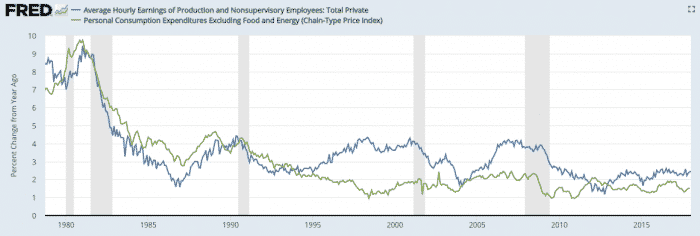The rise in average hourly earnings trails the 1990s and the 2000s
Now that the jobs numbers are out, I want to look at the wage data that everyone’s talking about. The January jobs report showed average hourly earnings rising at the fastest clip for eight-and-a-half years. And this will likely draw the Fed’s attention, since the unemployment rate is below the Fed’s longer term 4.6% target.
How the Fed takes in wage data
Before a show you the data, let me frame the situation. This will help show why the wage issue is so important.
The economics goes something like this:
- The Fed has a dual mandate to maintain inflation at a low and stable level over the longer-term. At the same time, it is tasked with making sure that the US economy has a maximum sustainable level of employment.
- The use of term ‘sustainable’ in the last bullet point infers a trade-off, meaning that — and this is controversial — many economists believe that unemployment levels that are too low make it difficult to maintain low and stable inflation levels (for more on this issue, see my post “Quick thoughts on the failure of Fed-engineered unemployment”).
- The Fed has targeted 2% as the best level to meet its inflation mandate. In this particular cycle, inflation has undershot that target for almost six years.
- Meanwhile unemployment levels have declined below levels where the Fed had believed the inflation rate would tend to accelerate upward.
- But because inflation remained below target, the Fed has lowered the unemployment level at which it believes the inflation rate would accelerate.
- The present long-term unemployment rate the Fed is using is 4.6%. Meanwhile, the actual unemployment rate is 4.1%. So the Fed has begun to slowly raise rates.
- Wage growth has finally started to show promise. And because the Fed considers accelerating wage growth a precursor to inflation, it now has a green light to tighten more aggressively.
- This is negative for fixed income assets, causing yields to rise and prices to fall.
The Fed ‘engineering’ unemployment for inflation’s sake
The important bits of the framing are twofold. First, the perception that the Fed must essentially engineer more unemployment in order to keep inflation in check seems perverse. As a result, some economists have suggested that policy makers create a job guarantee as a floor for work-related wages to keep the economy at a constant state of full employment. The government would instead use fiscal policy as the main vehicle for controlling inflation.
Second, the concept that the Fed only gets a green light to tighten aggressively when wages rise feeds a perception that monetary policy helps sustain inequality by suppressing wage growth. Therefore, If the Fed’s policy tightening ends in a recession, the institution would rightly face scrutiny for its role not just in creating recession, but also in unemployment and inequality.
So that’s the framing. Now to the data.
The average hourly earnings data in context
What I have done is show growth in average hourly earnings with the Fed’s preferred measure of inflation as a yardstick to help guide us in measuring how much inflation eats away at that growth.**
As inflation has fluctuated, wage growth has fluctuated in tow. However three distinct periods are apparent from the data. First, there was the 1980s when wage growth consistently trailed inflation. Then in the mid- to late-1990s a large gap opened up where wage growth was robust and inflation fell. Finally, in the last decade, inflation remained low even as wage growth moved upward from 2004 through 2007.
Conclusion
The present rise in average hourly earnings is not large in a longer-term context. We’re looking at about 1% in real terms. In the 2000s, we saw real earnings growth rise to 2% and in the late 1990s, it was even 3%.
My view: The question for Fed officials is whether they would allow real earnings growth to reach 2000s level or even 1990s. To do so would likely mean slowing the pace of rate hikes rather than accelerating them, as I think is more likely.
**Note: For my chart, I used earnings for production and non-supervisory employees instead of all private employees because the dataset for all employees only goes back to 2007. That matters because right now total employee earnings growth is 2.89%, which is higher than the 2.43% for nonsupervisory employees. While we’re still not at 2000s level growth, all private employees have seen an average 1.4% real earnings growth over the past year, versus a rise of 0.9% for non-supervisory employees.

Comments are closed.